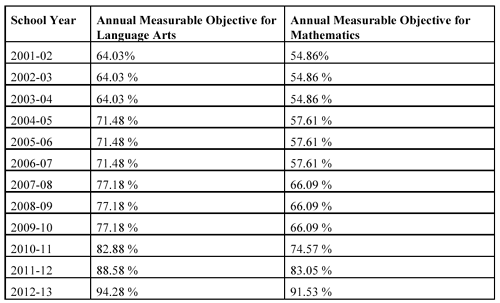 Preliminary "AYP List" Points Out Strengths and Weaknesses of Each School August 13, 2005
This year, statewide 292 schools made AYP targets and 203 did not make AYP out of a total of 495 schools. Last year 290 schools met AYP out of 497 schools; 207 schools did not make AYP. Based on 2004-2005 data, of the ten schools in Ketchikan, seven met Adequate Yearly Progress according to the state's preliminary list . They are the Ketchikan Charter School, Ketchikan High School, Ketchikan Regional Youth Facility, Point Higgins School, Schoenbar Middle School, Tongass School of Arts & Sciences, and White Cliff Elementary. Ketchikan schools included on the state's preliminary list of schools not meeting Adequate Yearly Progress are Houghtaling Elementary School, Ketchikan Correspondence School and Revilla Jr/Sr High School. In percentages, in Ketchikan this year 70% of the schools made AYP and 30% did not. In percentages, statewide this year 59% of schools made AYP and 41% did not make AYP. Last year 58% of schools made AYP and 42% did not make AYP. In 2003, the first year the department released the AYP lists, 42% of schools made AYP and 58% did not make AYP. Sampson cautioned that the preliminary AYP list reveals only part of the story about schools. He urged Alaskans to examine local school results closely to discover the strengths of their schools and to pinpoint where progress needs to be made. "There are many excellent schools in Alaska, some of which did not meet every AYP target," said Sampson. "In fact, many schools made substantial improvements in student achievement over the past two years, but did not meet AYP yet. Nevertheless, the progress these schools have made is remarkable." The preliminary AYP list gives the Alaska public important information about the performance of public schools. The information is based on how students scored on state examinations in language arts and math in grades three through nine and, for tenth graders, on the High School Graduation Qualifying Exam. It also reflects whether schools met minimum standards on school attendance rates and high school dropout rates. NCLB, passed by Congress in January 2002, requires schools to meet AYP with groups of students or be designated as needing improvement. Groups of students include: students with limited English proficiency; students with disabilities; economically disadvantaged students; African-Americans; Alaska Natives; American Indians; Asians; Hispanics; and Caucasians. There are a number of targets a school must meet:
There are up to 31 targets that a school must reach or the school does not make AYP. A school can be on the list by not making AYP with as few as one group of students on one test or by not making AYP with all categories of students on both tests. This means NCLB does not allow schools to hide the performance of a single group of students in a school's average performance. The AYP targets are so rigorous that if all students in a school score proficient on tests, a school will not make AYP if 95% of the students in a school are not tested. Schools on the list for the first time are called Level 1 schools; for the second year, Level 2; for the third, Level 3; for the fourth, Level 4, for the fifth, Level 5. If a school is at level 5 one year and does not meet again the next year they are at level 5 two consecutive years. Once a school has reached Level 2, the school must meet AYP targets for two consecutive years in order to be removed from the list. This year Alaska has 42 schools that are Level 2 or higher that met AYP this year. Alaska has two schools that were Level 2 or higher last year, but met for the second consecutive time this year and therefore are removed from the list. Targets, called Annual Measurable Objectives (AMO) by NCLB, increase over time. Alaska created new assessments in grades 3 through 9 this year to improve instructional feedback on student performance for students and schools, and to meet the requirements of NCLB. Because of the new assessments Alaska, with U.S. Department of Education approval, established a new AMO baseline this year, reflected in the AMO chart below.  In 2013-2014, 100% of students
in every group and schoolwide must achieve proficiency on state
tests. Sampson said NCLB is important for further pinpointing achievement gaps between groups of students. By requiring groups of students to make AYP, NCLB does not allow a school's average test scores to mask problem areas. Different consequences apply to schools that receive federal Title I funding from those that do not receive Title I funding. However, all Level 1 schools need to inform parents about their AYP status, and develop and implement a plan for improvement. If a Title I school does not make AYP for two consecutive years, the school enters Title I school improvement status. In that case, parents will be given a choice, if practical, for their child to attend a different school in their district that is not at Level 2 or higher, or the school must offer supplemental services to students. Consequences are more comprehensive for Level 3 and higher schools. The State Department of Education & Early Development on Friday posted the preliminary AYP list on the web, as well as other information helpful in interpreting the information.
On the Web:
Source:
Publish A Letter on SitNews Read Letters/Opinions Submit A Letter to the Editor
|